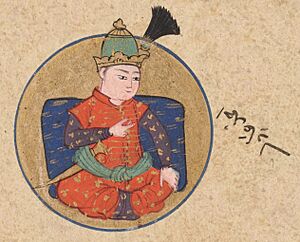Ahmad Samani facts for kids
Quick facts for kids Ahmad Samani |
|
|---|---|

Ahmad Samani from the genealogical tree of the Zübdet-üt Tevarih ("Cream of Histories"), dated 1598
|
|
| Amir of the Samanids | |
| Reign | 907–914 |
| Predecessor | Ismail Samani |
| Successor | Nasr II |
| Died | 24 January 914 |
| Issue | Nasr II Ibrahim ibn Ahmad |
| Dynasty | Samanid |
| Father | Ismail Samani |
| Religion | Sunni Islam |
Ahmad ibn Ismail (Persian: احمد سامانی) was a powerful ruler, known as an Amir (a type of prince or commander). He led the Samanids, a Persian empire, from 907 to 914. Ahmad was the son of Ismail Samani, who was also a famous Samanid ruler. People later called Ahmad the "Martyred Amir" because of how he died.
Contents
Becoming a Ruler
Ahmad first appears in history around the early 900s. He was given the job of governor in a region called Gurgan. However, he didn't stay in that role for long. He was removed because he didn't fight against the Justanids, another group in the area.
Ahmad became the new Amir of the Samanids in late 907. This happened after his father, Ismail Samani, passed away.
Expanding the Samanid Empire
After becoming Amir, Ahmad gained control over Sistan. This area was the main part of the Saffarid kingdom, which was a rival empire. The Caliph al-Muqtadir, a very important religious and political leader, gave Ahmad the rights to Sistan.
It was easier for Ahmad to take over Sistan because the Saffarids were fighting among themselves. Ahmad's army marched from Farah to Bust and faced little resistance. At the same time, his general, Simjur al-Dawati, took control of Zarang from al-Mu'addal.
By 911, the Samanids had fully conquered the Saffarid lands. The next year, Ahmad made his cousin, Abu Salih Mansur, the new governor of Sistan. The Samanids also captured a rebel leader named Sebük-eri and sent him to Baghdad.
Challenges and Rebellions
Abu Salih Mansur's rules in Sistan were not popular. Within a year, people in Sistan revolted against him. The Samanid soldiers in Zaranj were defeated, and Abu Salih Mansur was captured.
A Saffarid named Amr ibn Ya'qub became the new leader of the rebellion. At first, he was just a puppet ruler, but then he became the Amir himself. However, a Samanid army, led by Husain ibn 'Ali Marvarrudhi, quickly brought Sistan back under Samanid control. 'Amr was sent to Samarkand, and other rebel leaders were killed.
After this, Simjur al-Dawati was made the governor of Sistan. But new rebellions soon started in other regions like Tabaristan and Gurgan. Ahmad was killed before he could deal with these new problems.
The Death of Ahmad Samani
Ahmad was killed on January 24, 914. He was sleeping in his tent near Bukhara when some of his own slaves attacked him. After his death, his body was taken to Bukhara and buried in Naukanda. Some of the slaves who killed him were caught and executed, while others escaped.
Ahmad was given the title "Martyred Amir" because of his violent death. He might have become unpopular with his people for a short time. He had ordered that the language used in the court should change from Persian to Arabic. However, this order was quickly changed back.
Ahmad was succeeded by his young son, Nasr II.
Images for kids



